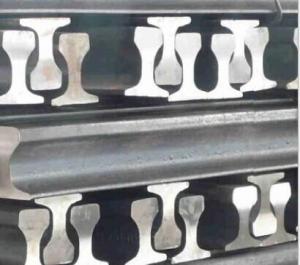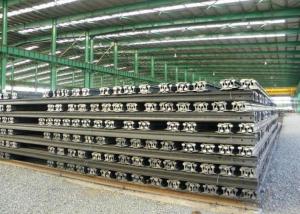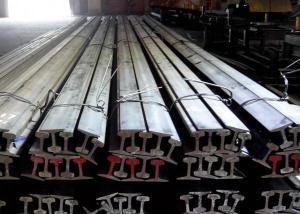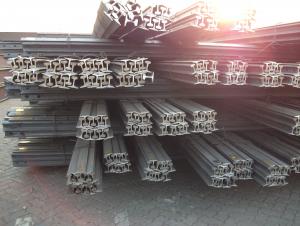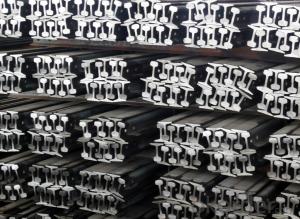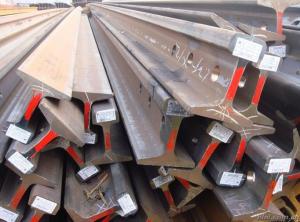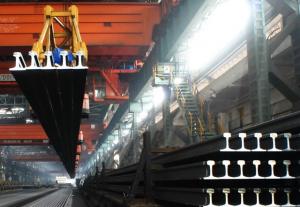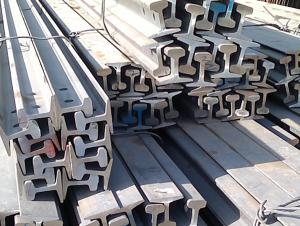Hot Rolled Light Steel Rail Q235 with High Quality
- Loading Port:
- China Main Port
- Payment Terms:
- TT or LC
- Min Order Qty:
- 20 m.t.
- Supply Capability:
- 5000 m.t./month
OKorder Service Pledge
OKorder Financial Service
You Might Also Like
Product Description:
OKorder is offering Hot Rolled Light Steel Rail Q235 with High Quality at great prices with worldwide shipping. Our supplier is a world-class manufacturer of steel, with our products utilized the world over. OKorder annually supplies products to European, North American and Asian markets. We provide quotations within 24 hours of receiving an inquiry and guarantee competitive prices.
Product Applications:
Hot Rolled Light Steel Rail Q235 with High Quality is mainly used in forest region, mines, factories and construction sites laid of the place such as temporary transport line and light motorcycles with line.
Product Advantages:
OKorder's Hot Rolled Light Steel Rail Q235 with High Quality are durable, strong, and with competitive price
Main Product Features:
· Premium quality
· Prompt delivery & seaworthy packing (30 days after receiving deposit)
· Corrosion resistance
· Can be recycled and reused
· Mill test certification
· Professional Service
· Competitive pricing
Product Specifications:
Manufacture: Hot rolled
Certificates: ISO, SGS, BV, CIQ
Length: 6m – 25m, as per customer request
Packaging: Export packing, nude packing, bundled
Production Standard: GB 11264-89, GB2585-81, AREMA2008, JIS, DIN536, EN13674-1-2003, etc.
Sizes: 9kg-60kg
FAQ:
Q1: Why buy Materials & Equipment from OKorder.com?
A1: All products offered byOKorder.com are carefully selected from China's most reliable manufacturing enterprises. Through its ISO certifications, OKorder.com adheres to the highest standards and a commitment to supply chain safety and customer satisfaction.
Q2: How do we guarantee the quality of our products?
A2: We have established an advanced quality management system which conducts strict quality tests at every step, from raw materials to the final product. At the same time, we provide extensive follow-up service assurances as required.
Q3: How soon can we receive the product after purchase?
A3: Within three days of placing an order, we will begin production. The specific shipping date is dependent upon international and government factors, but is typically 7 to 10 workdays.
Q4:What is the package
A4: Standard seaworthy packing or as customer required; all goods are packed in bundle with steel strips and shipped by break bulk vessel or container
Q5:Can OKorder.com make the color marking?
A5: There will be color marking on both end of the bundle for the cargo delivered by bulk vessel. That makes it easily to distinguish at the destination port.
Images:
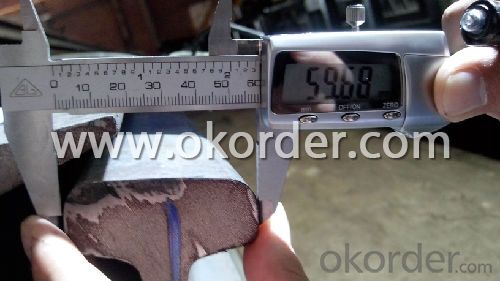
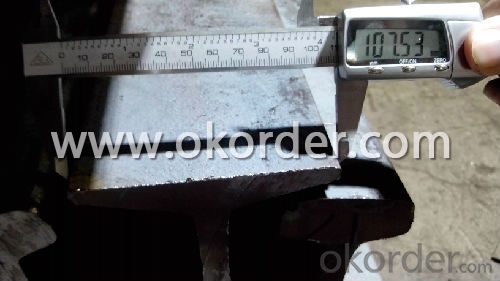
- Q:How are steel rails affected by changes in humidity?
- Steel rails are affected by changes in humidity through the process of corrosion. When humidity levels increase, moisture in the air can come into contact with the steel rails, leading to the formation of rust. This rust weakens the rails over time, making them more prone to damage and reducing their overall lifespan. Therefore, changes in humidity can have a detrimental effect on the durability and safety of steel rails.
- Q:What is the typical hardness of steel rails?
- The typical hardness of steel rails is around 200 to 300 Brinell hardness units (BHN).
- Q:How are steel rails protected against extreme temperature fluctuations?
- Steel rails are protected against extreme temperature fluctuations through a combination of design and maintenance measures. One of the primary methods used is the inclusion of expansion joints in the rail system. These joints allow the rails to expand and contract with changes in temperature, preventing them from buckling or becoming distorted. Additionally, steel rails are often coated with a protective layer, such as paint or corrosion-resistant material, to prevent rust and corrosion. This coating helps to maintain the structural integrity of the rails, even in harsh weather conditions. Furthermore, regular maintenance is crucial in ensuring the resilience of steel rails against extreme temperature fluctuations. Inspection and monitoring are carried out to identify any issues such as cracks, fatigue, or wear, which can be exacerbated by temperature changes. Maintenance crews also address any identified problems promptly, such as replacing worn or damaged rails, to prevent further deterioration. In some cases, advanced techniques like thermite welding are used to repair or replace damaged rail sections. This process ensures a strong and durable bond between the rails, improving their ability to withstand temperature changes. By employing a combination of design features, protective coatings, and ongoing maintenance, steel rails are effectively protected against extreme temperature fluctuations, allowing for safe and reliable railway operations even in the most challenging weather conditions.
- Q:How are steel rails protected from rust?
- Steel rails are protected from rust through a process called corrosion protection. There are several methods used to ensure the longevity of steel rails by preventing rust formation. One common method is through the application of a protective coating. This involves applying a layer of paint or a specialized protective coating on the surface of the steel rails. The coating acts as a barrier between the steel and the surrounding environment, preventing moisture and oxygen from reaching the metal surface and causing rust. The coating also helps to protect the steel from other corrosive substances such as chemicals or pollutants. Another method used for rust protection is galvanization. Galvanization involves the application of a layer of zinc on the surface of the steel rails. This process creates a protective barrier that not only prevents rust formation but also provides additional durability to the steel. Galvanized steel rails are commonly used in outdoor environments or areas with high exposure to moisture, as they offer superior corrosion resistance. Regular maintenance and inspection are also crucial for protecting steel rails from rust. Any signs of damage to the protective coating or galvanized layer should be addressed promptly to prevent rust from developing. This may involve recoating damaged areas or applying a corrosion inhibitor to prevent further rusting. Overall, steel rails are protected from rust through the application of protective coatings, galvanization, and regular maintenance. These measures ensure that the rails can withstand the harsh conditions they are exposed to and maintain their structural integrity over time.
- Q:What are the safety regulations for steel rails?
- The safety regulations for steel rails primarily involve ensuring their proper installation, maintenance, and inspection. These regulations typically include specifications for the size, weight, and structural integrity of the rails, as well as guidelines for their alignment, fastening, and support systems. Regular inspections are mandated to identify any defects or wear that could compromise safety, and measures such as repairing or replacing damaged rails are enforced to maintain a secure railway infrastructure. Additionally, safety protocols for workers involved in rail construction or maintenance, such as wearing appropriate protective gear, may also be part of the regulations.
- Q:What's the difference between a hot rail and a heat treated rail?
- Surface heat treatment, such as surface hardening. There is still a difference, but for the same material, heat treatment is the same.
- Q:How does the weight of steel rails affect their performance?
- The performance of steel rails is significantly impacted by their weight. A heavier rail generally provides greater stability and durability, reducing the likelihood of wear and deformation. The weight of the rail helps evenly distribute the load of passing trains, decreasing the risk of rail buckling or bending. Additionally, the weight of steel rails affects their ability to handle heavy loads and maintain track alignment. Heavier rails offer better resistance to lateral forces, ensuring that the track remains straight and aligned, even under the pressure of passing trains. This is particularly important for high-speed rail systems or tracks with heavy freight traffic. Furthermore, the weight of steel rails plays a critical role in determining their ability to withstand fatigue and maintain structural integrity over time. Heavier rails have higher resistance to fatigue caused by the repeated stress of trains passing over the track. This prolongs the rail's lifespan and reduces the need for frequent maintenance or replacement. However, it is crucial to find a balance between the weight of the rail and other factors such as track design, rolling stock, and operating conditions. If the rail is too heavy, it may increase overall costs of the railway system, requiring more material and energy for production, transportation, and installation. Moreover, the weight of the rail can impact the energy consumption of trains, as heavier rails increase rolling resistance. In conclusion, the weight of steel rails directly impacts their stability, durability, load-bearing capacity, track alignment, fatigue resistance, and maintenance requirements. Determining the optimal weight for rails involves considering various factors and striking a balance between performance, cost-effectiveness, and energy efficiency.
- Q:Can steel rails withstand extreme weather conditions?
- Yes, steel rails are designed to withstand extreme weather conditions. Steel is a highly durable material that is resistant to corrosion, high temperatures, and other environmental factors. This makes steel rails capable of withstanding extreme weather conditions such as heavy rain, snow, extreme heat, and freezing temperatures without significant damage or deterioration.
- Q:What are the different methods of measuring rail temperature and expansion using steel rails?
- There are several methods for measuring rail temperature and expansion using steel rails. One common approach is using infrared thermometers or thermal imaging cameras to measure the surface temperature of the rail. Another method involves installing temperature sensors or thermocouples at various points along the rail to monitor and measure temperature changes. Additionally, expansion joints or expansion devices can be used to measure the expansion and contraction of the rail due to temperature fluctuations. These methods help ensure the safe operation and maintenance of rail infrastructure.
- Q:How do steel rails handle different types of train speeds?
- Steel rails are specifically designed to handle different types of train speeds. They are built with high strength and durability to withstand the forces exerted by trains traveling at varying speeds. The rails are carefully engineered to minimize vibration and maintain stability, ensuring safe and smooth passage for trains of different velocities.
1. Manufacturer Overview |
|
|---|---|
| Location | |
| Year Established | |
| Annual Output Value | |
| Main Markets | |
| Company Certifications | |
2. Manufacturer Certificates |
|
|---|---|
| a) Certification Name | |
| Range | |
| Reference | |
| Validity Period | |
3. Manufacturer Capability |
|
|---|---|
| a)Trade Capacity | |
| Nearest Port | |
| Export Percentage | |
| No.of Employees in Trade Department | |
| Language Spoken: | |
| b)Factory Information | |
| Factory Size: | |
| No. of Production Lines | |
| Contract Manufacturing | |
| Product Price Range | |
Send your message to us
Hot Rolled Light Steel Rail Q235 with High Quality
- Loading Port:
- China Main Port
- Payment Terms:
- TT or LC
- Min Order Qty:
- 20 m.t.
- Supply Capability:
- 5000 m.t./month
OKorder Service Pledge
OKorder Financial Service
Similar products
New products
Hot products
Related keywords


